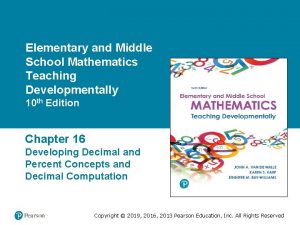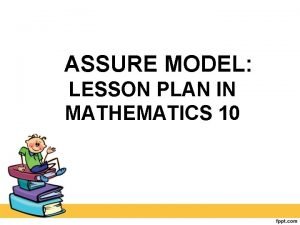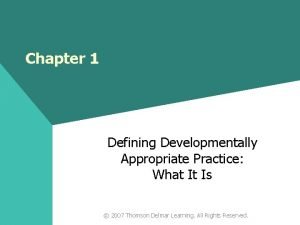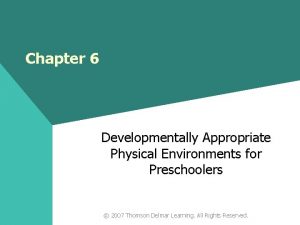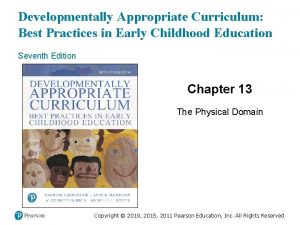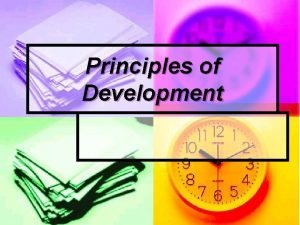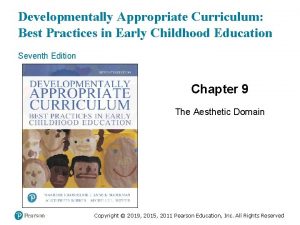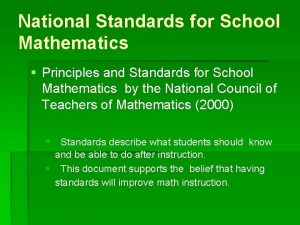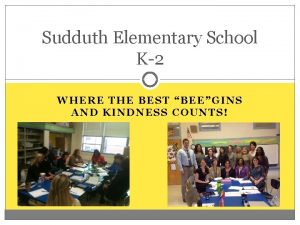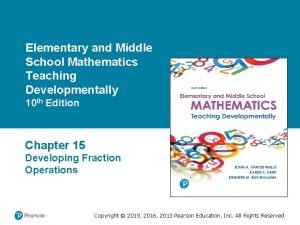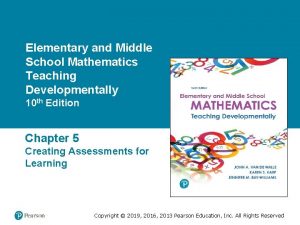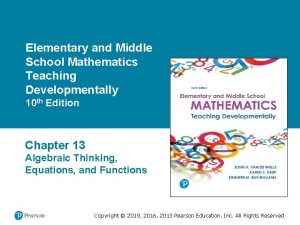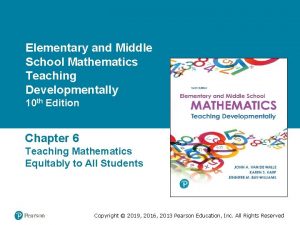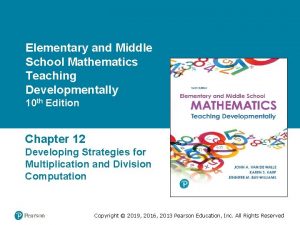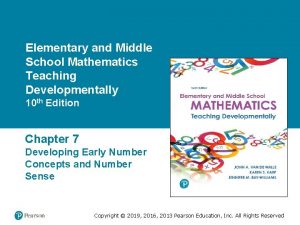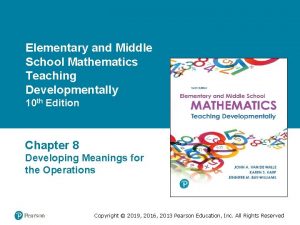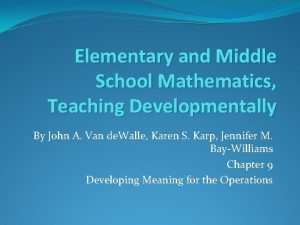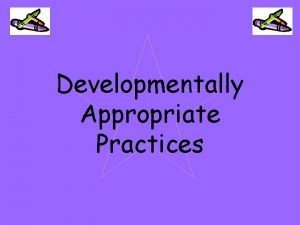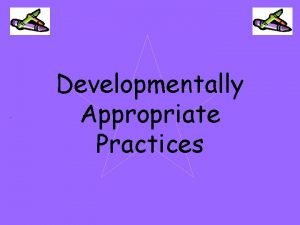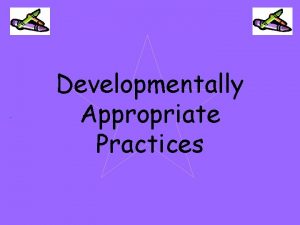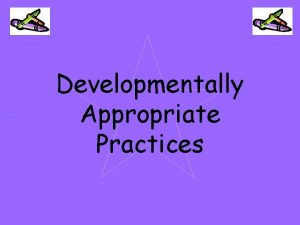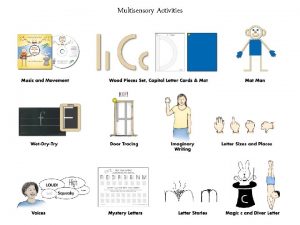Elementary and Middle School Mathematics Teaching Developmentally 10


























- Slides: 26

Elementary and Middle School Mathematics Teaching Developmentally 10 th Edition Chapter 14 Developing Fraction Concepts Copyright © 2019, 2016, 2013 Pearson Education, Inc. All Rights Reserved

Learner Outcomes 14. 1 Describe and give examples for fractions constructs and fraction models. 14. 2 Explain foundational concepts of fractional parts, including iteration and partitioning. 14. 3 Illustrate the concept of equivalence across fraction models. 14. 4 Describe strategies for comparing fractions and ways to teach this topic conceptually. Copyright © 2019, 2016, 2013 Pearson Education, Inc. All Rights Reserved

Standards-Based Development Students need significant time and experiences to develop a deep conceptual understanding of this important topic. 1 st and 2 nd Students partition shapes and refer to the fraction amounts as equal shares. 3 rd Major emphasis with attention to using fraction symbols, exploring unit fractions, and comparing fractions 4 th The focus is on fraction equivalence and beginning work on fraction operations (+, -, ×, ÷). Copyright © 2019, 2016, 2013 Pearson Education, Inc. All Rights Reserved

Fraction Constructs Part-whole Division Shading a region Sharing into equal-sized groups Part of a group of objects Often not thought of with fractions Part of a length Operator Measure Identifying a length and using that as a measurement unit to determine the length Fractions as multiples of unit fractions Used to indicate an operation Ratio the probability of an event is one in four Copyright © 2019, 2016, 2013 Pearson Education, Inc. All Rights Reserved

Models for Fractions Model Category Description Examples of Visuals and Manipulatives Examples of Contexts Area Fractions are determined on how a part of a region or area relatives to the whole area or region. Fraction Circles/ Rectangles Pattern Blocks Tangrams Geoboard Grid paper regions Clock Pan of Brownies Quesadillas (circular food) Garden Plot or Playground Length Fractions are illustrated as a subdivision of a length of a paper strip (representing a whole), or on a number line that shows the fraction’s position from zero (either positive or negative fractions). Paper stripes Cuisenaire Rods Number lines Fraction towers Measuring cup Walking/Distance travelled String lengths Music measures Set Fractions are determined based on how many discrete items are in the whole set, and how many items are in the part. Counters (e. g. , two color counters, colored cubes) Objects (e. g. , pencils, toys) Egg carton Students in the class, school, stadium Type of item in a bag of items Copyright © 2019, 2016, 2013 Pearson Education, Inc. All Rights Reserved

Fraction Area Models Area models are a good place to begin with because they lend themselves well for equal sharing and partitioning. Copyright © 2019, 2016, 2013 Pearson Education, Inc. All Rights Reserved

Fraction Length Models Length models are physical materials that are compared on the basis of length or number lines are subdivided. Fractions are numbers that expand our number system beyond whole numbers. Copyright © 2019, 2016, 2013 Pearson Education, Inc. All Rights Reserved

Fraction Set Models Set models The whole is understood to be a set of objects, and the subsets of the whole make up fractional parts. Copyright © 2019, 2016, 2013 Pearson Education, Inc. All Rights Reserved

Activity 14. 3 Class Fractions Materials- students Directions – see below Use a group of students as the whole — for example, six students if you want to work on halves, thirds, and sixths. Invite them to come to the front of the room. Say to the group, “If you [are wearing tennis shoes, have brown hair, etc. ], move to the right. If not, move to the left. ” Ask everyone, “What fraction of our friends [are wearing tennis shoes]? ” Invite them to whisper to a partner, then share with the class. Change the number of selected students in the whole. You can ask, “How many friends in one-half of this group? One-fourth of this group? ” Connect to the asking students to write the fraction that symbols for fractions tells how many students are wearing [tennis shoes]. Also, if you have six students in your group, and have three in your subgroup, then students are likely to say “three-sixths” and “one-half”. Discuss that these values are equivalent. Copyright © 2019, 2016, 2013 Pearson Education, Inc. All Rights Reserved

Sharing Tasks Students need experiences with fairly sharing items to begin the development of fractions. Student thinking about sharing brownies and pizza Three features: Objects in story are easy to draw and partition No fractions in the story - they emerge from the partitioning. Can be solved with no formal fraction instruction or fraction symbols Copyright © 2019, 2016, 2013 Pearson Education, Inc. All Rights Reserved

Partitioning with Area Model (1 of 2) 1. Fractional parts must be the same size, though not necessarily the same shape. 2. The number of equal-sized parts that can be partitioned within the unit determines the fractional amount. Copyright © 2019, 2016, 2013 Pearson Education, Inc. All Rights Reserved

Partitioning with Area Model (2 of 2) Which of these shows fourths? 1. Same shape, same size: a and f (equivalent) 2. Different shape, same size: e and g (equivalent) 3. Different shape, different size: b and c (not equivalent) 4. Same shape, different size: d (not equivalent) Which category do these fall into? Copyright © 2019, 2016, 2013 Pearson Education, Inc. All Rights Reserved

Partitioning with Length Models (1 of 2) Students need to be able to partition a number line into parts and realize what part of the whole the section represents. Activity 14. 7 Materials. Partitioned number lines Copyright © 2019, 2016, 2013 Pearson Education, Inc. All Rights Reserved

Partitioning with Length Models (2 of 2) Partitioning using a length diagram is a strategy commonly used in Singapore as a way for solving story problems. Try This One A nurse has 54 bandages. If 2/9 are white and the rest are brown, how many are brown? A length diagram is used by a student to partition into nine parts and then figure out the equal shares of the bandages for each partition. Copyright © 2019, 2016, 2013 Pearson Education, Inc. All Rights Reserved

Partitioning with Set Models Students can partition with set models such as coins, counters, or baseball cards. When equal parts are not already figured out, students may not see how to partition. Understanding that parts of the whole must be partitioned into equal-sized parts across different models is important. Copyright © 2019, 2016, 2013 Pearson Education, Inc. All Rights Reserved

Iterating Counting fractional parts, or iterating helps students understand the relationship between the parts (numerator) and the whole (denominator). • The top number (numerator) counts; • The bottom number (denominator) tells what is being counted; • is a count of three parts called fourths, for example of ribbon and needs pieces that are one-fourth yards for making bows. How many pieces can she cut? Draw a strip or line to represent the Partition the strip into fourths. Copyright © 2019, 2016, 2013 Pearson Education, Inc. All Rights Reserved

Iterating Fractions Greater Than One Whole Count the parts one-fourth, two fourths, three fourths, five fourths Ask questions to make comparisons between different collections of parts. Copyright © 2019, 2016, 2013 Pearson Education, Inc. All Rights Reserved

Estimating with Fractions Benchmarks of zero, one-half, and one Using number sense to compare About how much Name a fraction for each drawing and explain why you chose that fraction. Focus on the infinite number of fractions that can be use to explain between 0, 1 and. Copyright © 2019, 2016, 2013 Pearson Education, Inc. All Rights Reserved

Equivalent Fraction Models Area models for equivalent fractions help students create understanding. Copyright © 2019, 2016, 2013 Pearson Education, Inc. All Rights Reserved

Activity 14. 17 Apples and Bananas Materials - 24 counters in all - Two colors: 16 red and 8 yellow Directions - Group the counters into different fractional parts of the whole and use parts to create fraction names for the fractions that are apples and fractions that are bananas. Ask- Is it possible to have fruit in groups of 4? Copyright © 2019, 2016, 2013 Pearson Education, Inc. All Rights Reserved

Developing Equivalent-Fraction Algorithm Area model is a good visual to connect concept of equivalence to the standard algorithm. The approach would be to look for a patterns in the way that the fractional parts in both the part and whole are counted. Copyright © 2019, 2016, 2013 Pearson Education, Inc. All Rights Reserved

Writing Fractions in Simplest Terms A fraction in simplest terms means that the numerator and denominator have no common whole-number factors. Reducing fractions implies that the fraction is getting smaller and this is not true. Avoid that term. Accept all equivalent fractions and not say that an answer is “incorrect” if not in simplest terms. Copyright © 2019, 2016, 2013 Pearson Education, Inc. All Rights Reserved

Comparing Fractions Which fraction in each pair is greater? Give one or more reasons. Try not to use drawings or models. Do not use common denominators or cross-multiplication. Ways that the fractions could have been compared: • Same-size denominator • Same numerator • More than/less than benchmark (0, ½, or 1) • Closeness to a benchmark Copyright © 2019, 2016, 2013 Pearson Education, Inc. All Rights Reserved

Teaching Considerations for Fractions Concepts 1. Emphasize number sense and meaning of fractions. 2. Provide a variety of models and contexts. 3. Emphasize that fractions are numbers-Make extensive use of number lines in representing fractions. 4. Dedicate time for understanding of equivalence (concretely, symbolically). 5. Link fractions to key benchmarks and encourage estimation. Copyright © 2019, 2016, 2013 Pearson Education, Inc. All Rights Reserved

Common Challenges and Misconceptions for Fraction Concepts (1 of 2) Challenges and Misconceptions 1. Numerator and denominator are separate numbers (not seeing a fraction as a number) What It Looks Like Three fourths How to Help is seen as a 3 over a 4. Student cannot locate a fraction such as three fourths on a number line because they don’t think it is a number. 2. Fractional parts do not need to be equal-sized Three fourths (three-fourths) of the figure below is light gray. * The figure has 4 block shapes. At the center is a trapezoid, with a triangle Find fraction values on a number line (e. g. , a warm-up activity each day where students place values on a classroom number line). Measure with inches to various levels of precision (e. g. , to the nearest fourth, eighth, or sixteenth). Avoid the phrase “three out of four” (unless you are talking about ratios or probability) or “three over four”; instead, say “three-fourths” (Siebert & Gaskin, 2006). Have students create their own representations of fractions across various types of models. Provide problems like the one illustrated here, in which all the partitions are not already drawn and have students draw or show the equal-sized parts. aligned against each of its left, right, and top sides. how to help. *green if using pattern blocks Copyright © 2019, 2016, 2013 Pearson Education, Inc. All Rights Reserved

Common Challenges and Misconceptions for Fraction Concepts (2 of 2) Fractional parts must be the same size. Fractions with larger denominators are bigger. Fractions with larger denominators are smaller. Representing fractions greater than 1. Determining a whole when given a part. Copyright © 2019, 2016, 2013 Pearson Education, Inc. All Rights Reserved
 Elementary and middle school mathematics 10th edition
Elementary and middle school mathematics 10th edition Dpscd.schoology
Dpscd.schoology Assure lesson plan
Assure lesson plan Japanese male school uniforms
Japanese male school uniforms Utilitarian aims of teaching mathematics
Utilitarian aims of teaching mathematics Teaching approach
Teaching approach Difference between micro teaching and traditional teaching
Difference between micro teaching and traditional teaching Developmentally appropriate practice for kindergarten
Developmentally appropriate practice for kindergarten Developmentally appropriate programs are based on
Developmentally appropriate programs are based on Developmentally appropriate environment
Developmentally appropriate environment Developmentally appropriate curriculum 7th edition
Developmentally appropriate curriculum 7th edition Define developmentally appropriate practice
Define developmentally appropriate practice Principles of developmentally appropriate practice
Principles of developmentally appropriate practice An appropriate developmental curriculum
An appropriate developmental curriculum Developmentally appropriate curriculum 7th edition
Developmentally appropriate curriculum 7th edition Principles and standards for school mathematics
Principles and standards for school mathematics Holland middle school track
Holland middle school track Ubujan elementary school
Ubujan elementary school Family sis schoolmax
Family sis schoolmax Mackay elementary school tenafly
Mackay elementary school tenafly Sealey elementary school
Sealey elementary school Leila davis elementary
Leila davis elementary Wexford elementary
Wexford elementary Kistler elementary school
Kistler elementary school Weatherstone elementary
Weatherstone elementary Terry fox elementary school
Terry fox elementary school Sudduth elementary school
Sudduth elementary school
